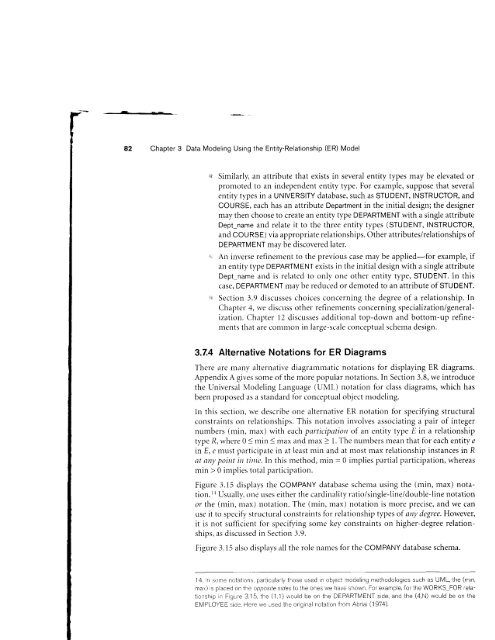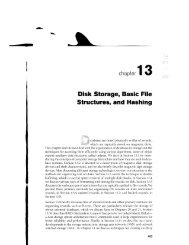this pdf excerpt
this pdf excerpt
this pdf excerpt
You also want an ePaper? Increase the reach of your titles
YUMPU automatically turns print PDFs into web optimized ePapers that Google loves.
Chapter 3 Data Modeling Using the Entity-Relationship (ER) Model<br />
Similarly, an attribute that exists in several entity types may be elevated or<br />
promoted to an independent entity type. For example, suppose that several<br />
entity tvpes in a UNIVERSITY database, such as STUDENT, INSTRUCTOR, and<br />
COURSE, each has an attribute Department in the initial design; the designer<br />
may then choose to create an entity type DEPARTMENT with a single attribute<br />
Dept_name and relate it to the three entity types (STUDENT, INSTRUCTOR,<br />
and COURSE) via appropriate relationships. Other attributes/relationships of<br />
DEPARTMENT may be discovered later.<br />
An inverse refinement to the previous case may be applied-for example, if<br />
an entity type DEPARTMENT exists in the initial design with a single attribute<br />
Dept-name and is related to onll' one other entity type, STUDENT. In <strong>this</strong><br />
case, DEPARTMENT r-r-ray be reduced or demoted to an attribute of STUDENT.<br />
Section 3.9 discusses choices concerning the degree of a relationship. In<br />
Chapter 4, we discuss other refinenlents concerning specialization/generalization.<br />
Chaplsl l2 discusses additional top-dorvn and bottom-up refinen-rents<br />
that are comnron in large-scale conceptual schema design.<br />
3.7.4 Alternative Notations for ER Diagrams<br />
There are rnan,v alternative diagrar.nmatic notatiolrs fbr displaying ER diagrams.<br />
Appendix A give's some of the more popular notations. In Section 3.8, we introduce<br />
the Universarl N,lodeling Language (UML) notation for class diagrams, which has<br />
been proposed as a standard fbr conceptuirl object n-rodeling.<br />
In <strong>this</strong> section, we describe one alternative ER notation fbr specifying structural<br />
constraints on relationships. This notation involves associating a pair of integer<br />
numbers (min, max) with each pnrticiptrtiott of an entity type E in a relationship<br />
type R, where 0 ( min ( rnax irnd rnax ) l. The numbers mean that for each entity e<br />
in E, c mr-rst prarticipate in at least min and at u.tost max relationship instances in R<br />
at any point irr titrre.ln <strong>this</strong> r.nethod, min = 0 implies partial participation, whereas<br />
min > 0 implies total participation.<br />
Figure 3.15 displays the COMPANY database schema r-rsing the (min, max) notation.ra<br />
Usually, tlne r-rses either the cardinality ratio/single-line/double-line notation<br />
or the (min, nrirx) notation. The (rnin, max) notation is more precise, and we can<br />
use it to specify structural constraints for relationship types of any degree. However,<br />
it is not sufficient for specifuing some ke1' constraints on higher-degree relationships,<br />
as discussecl in Section -3.9.<br />
Figure 3.15 also displays all the role names for the COMPANY database schema.<br />
14. n some notatons, particularly those used in oblect rnodeling methodologies such as UML, the (mrn,<br />
rnax) s p aced on the opposite srdes to the ones we have shown. For example, for the WORKS FOR relatonship<br />
n Fgure 3,15, the (1,1)would be on the DEPARTMENT side, and the (4,N) would be on the<br />
EN/PLOYEE side, Here we used the orq nal notation trom Abriai (1974).














